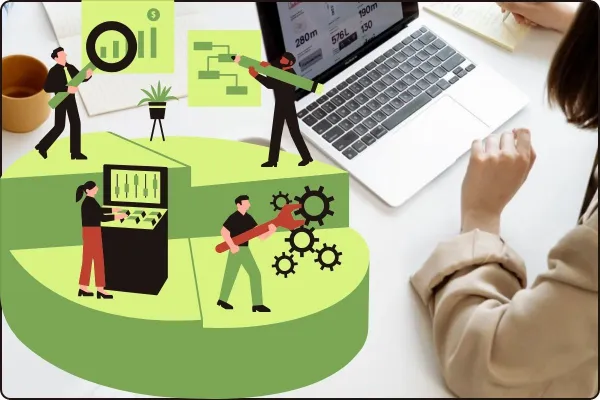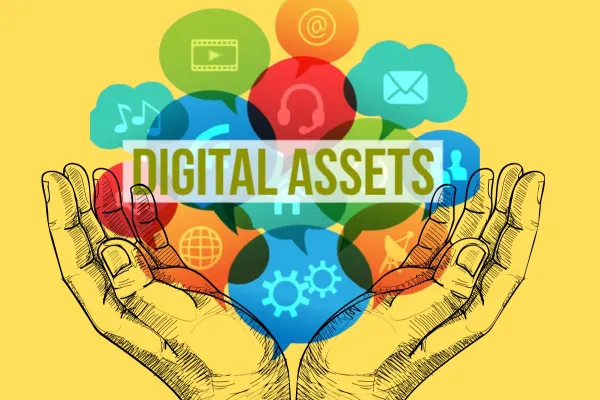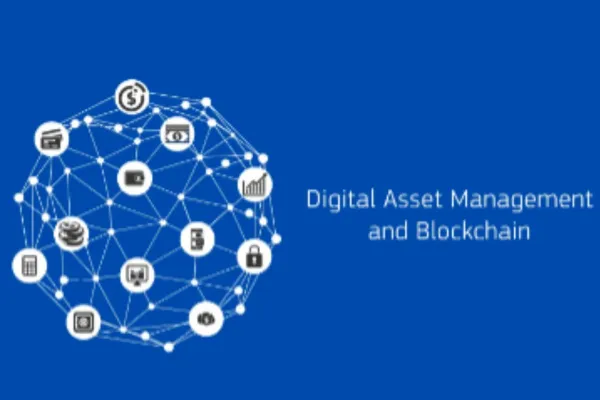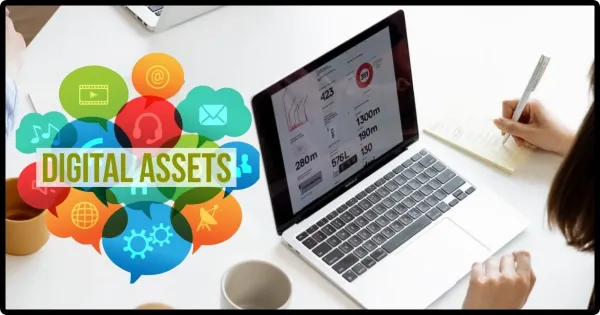Entering the Digital Age-The Role of Digital Asset Management Software
I. Introduction
In the ever changing digital world, organisations from a wide range of industries are being flooded with an unprecedented amount of digital assets . Images, movies, documents, marketing materials, design files, and a vast variety of other information are all included in these assets. The effective administration of these digital assets must be prioritised by the businesses that want to succeed in the digital world.

A. Definition of Digital Asset Management (DAM)
Digital Asset Management (DAM) ,is a complete strategy and a set of procedures for effectively organising,storing, retrieving and distributing digital assets.These assets ,which might include textual papers and multimedia content ,are the foundation of modern businesses.
What is cloud digital asset management DAM
B. Importance of DAM in the Digital Age
The growth of digital material and the rise of remote work have made DAM more important than ever before.Maintaining brand consistency, facilitating collaboration, guaranteeing data security, and maximising the value of digital assets are challenges that businesses must overcome.DAM software emerges as a solution to these complex problems.
C. Purpose of Digital Asset Management Software
Digital Asset Management (DAM) software is the backbone of every successful DAM strategy. Organisations use this software as the main centre for managing their digital assets at every stage of their lifespan. It enables teams to efficiently and accurately store, arrange, search for, access, and distribute assets. DAM software also offers a number of features that promote collaboration, uphold brand consistency, and follow security and compliance guidelines.
As we delve deeper into the world of DAM software, we will examine the fundamental characteristics, advantages,various types, selection standards, and best practices for implementation.we will also look into the DAM’s changing trends and future prospects,providing information on how companies can use technology to their advantage to effectively traverse the digital landscape.
Come along with me ,as I explore the transformative potential of digital asset management software,where the effective management of digital assets paves the way for growth ,creativity and productivity in the digital age.
This table outlines the key components of a Digital Asset Management (DAM) system, including its user interface, database, storage, and various functionalities that help organizations manage their digital assets effectively.
Component
| User interface | |
| Metadata Database | |
| Storage Repository | |
| Asset Ingestion | |
| Metadata Management | |
| Version Control | |
| Access Control | |
| Workflow Automaton | |
Asset Retrieval | |
| Reporting & Analytics | |
| Integration | |
Security & Compliance | |
| Backup & Recovery |
Description
| The front-end where users interact with the DAM system. It includes features for asset search, preview, and metadata management. |
| A database that stores metadata associated with digital assets. This includes information like file name, description, keywords, and more. |
| The backend storage where digital assets are securely stored. This can include on-premises servers or cloud storage solutions. |
| The process of adding digital assets to the DAM system. This can be done manually or through automated bulk uploads. |
| Tools for tagging, categorizing, and organizing assets with metadata, making them easier to search and retrieve. |
| A system for tracking and managing different versions of digital assets, ensuring users access the most up-to-date files. |
| Permissions and user roles that regulate who can view, edit, or download specific assets, maintaining security and privacy. |
| Streamlining processes like approvals, reviews, and distribution of assets, improving efficiency and collaboration. |
| Features and tools that enable users to quickly find and retrieve specific assets based on search criteria. |
| Providing insights into asset usage, download history, and user engagement to inform decision-making. |
| The ability to integrate with other software, such as content management systems, marketing automation tools, and creative software. |
| Ensuring that assets are protected, encrypted, and compliant with industry regulations, such as GDPR or HIPAA. |
Regularly backing up digital assets and having a plan in place for data recovery in case of unexpected events. |
Unveiling the Core Capabilities-Key Features of DAM Software

II. Key Features of Digital Asset Management Software
Digital asset management software enables organisations to effectively manage their constantly growing digital asset collections with the help of a comprehensive range of tools and capabilities.These software solutions come equipped with number of key features that are important for effective digital asset management.
A. File Storage and Organization
DAM software provides centralised, secure storage for digital assets and frequently makes use of cloud-based or on-premises storage solutions.it enables the organised classification of assets, frequently through folder structures or metadata tagging,making it simple to find and manage files.
B. Metadata Management
Metadata is essential for asset identification and searchability.Users of DAM systems can add comprehensive metadata ,such as descriptions ,keywords,copyright information,and more,to each item.This metadata improves the speed of search, filtering, and asset retrieval.
C. Search and Retrieval Capabilities
DAM software is known for it’s powerful search capabilities.Users may quickly identify certain assets by using advanced search features,doing keyword searches, and filtering assets based on variety of parameters.This accelerates workflow efficiency and cuts down on time wasted looking for assets.
D. Version Control
In collaborative environments, maintaining version control is important.Version history tracking in DAM system ,ensuring that users can access and revert to previous versions of assets when needed.This functionality prevents data loss and misinterpretation in team projects.
E. User Access and Permissions
DAM solutions provide granular control over user access and permissions.Administrators can define who can view, download,delete, edit assets.This degree of control improves security and ensures adherence to data privacy laws.
F. Integration with other Software/Tools
To streamline workflows, DAM software often integrates with other crucial technologies like content management system (CMS) ,marketing automation platforms,design software and more to optimise operations.Distribution of assets across channels is made easier through integration.
These key features collectively empower organisations to effectively manage their digital assets ,fostering collaboration,ensuring data veracity,and maintaining brand consistency.Digital Asset Management Software acts as a hub for entire lifecycle of digital assets,from creation and organisation through distribution and archival
As we go further into the realm of DAM software, we’ll examine the real benifits it offers to organizations, enabling them to maximise the value of their digital assets in the digital age.
Unlocking Efficiency-The Benefits of Digital Asset Management Software

III. Benefits of Using DAM Software
These benefits extend across various aspects of business operations and include:
Adopting digital asset management software provides businesses with a wide range of significant advantages, making it an ideal investment in the current digital environment.
These advantages, which cover a variety of the business procedures and include.
A. Improved Workflow Efficiency
DAM software streamlines all stages of the lifecycle of digital assets.It makes asset creation ,storage, retrieval and distribution simpler.This efficiency reduces redundant jobs, saves time,and boosts overall productivity.
B. Enhanced Collaboration
DAM systems facilitate seamless collaboration.Teams can access and work on assets from any location, promoting a culture of remote and cross functional collaboration.Effective teamwork is facilitated by comments,annotations and version history tracking.
C. Brand Consistency
Maintaining brand consistency is essential in today’s cutthroat market.DAM software makes sure that all digital assets ,from logos to marketing materials,follow brand requirements .This consistency reinforces brand identity and trust among customers.
D. Cost Savings
Organisations can prevent duplication of work, lower the risk of licence non-compliance, and improve asset usage decisions by centralising asset management.This can lead to significant cost reduction in the long run.
E. Security and Compliance
DAM solutions provide strong security features including audit trails, encryption,and access control . This makes sure that organisations can follow data privacy laws and compliance standards and that sensitive digital assets are protected from unauthorised access.
F. Quick Asset Retrieval
With robust search capabilities and metadata tagging,DAM software enables users to find assets quickly.This eliminates the need to search through files or ask coworkers for assets,this shortens the time it takes to produce and distribute content.
G. Scalability
As digital asset repositories expand ,DAM software can scale with the organisations needs .Weather you have a few hundred or a few million in assets,the system remains flexible and can meet the growing demands.
H. Analytics and Insights
DAM system often feature analytics capabilities that provide insight into the usage and performance of assets.This data aids organizations make data driven decisions ,optimize content strategies and refine marketing initiatives.
I. Remote Accessibility
In an age of remote work, DAM software enables users to view and collaborate on assets from any location with an internet connection.This flexibility improves the agility and mobility of the workforce.
J. Reduction in Content Duplication
DAM software facilitates asset discovery, which reduces content duplication.This reduces the chance of using outdated or inaccurate assets,improving content accuracy and quality.
These benefits enable businesses to fully utilise the potential of their digital assets, from increasing productivity and teamwork to securing brand integrity and lowering operating costs.
Digital Asset Management software is a game changing technology in the digital age ,that help businesses succeed in an increasingly digital and competitive world.
Exploring Diversity-Different Types of DAM Software

IV. Types of Digital Asset Management Software
Digital asset management are available in different forms,each of which is tailored to the architecture,tastes and needs of a particular organisation . Understanding these types can help businesses make informed decisions when choosing the best DAM system.The main types of DAM software include.
A. On-Premises DAM Solutions
On premises DAM software is hosted and managed on an organisations own servers and infrastructure . Although if offers total control over data and security but requires significant IT resources for maintenance and updates. This type of DAM is preferred by businesses with strict data security and regulatory requirements.
B. Cloud-Based DAM Solutions
Cloud based DAM solutions, also referred to as Software as a Service (SaaS) DAM,are housed on the vendors servers and accessed online.They provide scalability, simplicity of use, and reduced IT overhead. Cloud DAM is suitable for businesses looking for adaptability and resource scalability .
C. Open-Source DAM Software
Open source DAM software is created by a group of contributors,Usually offered for free. It can be altered and tailored by organisations to meet their own requirements. Open-source DAM may be less expensive, but setup and maintenance may need more technical know-how.
D. Industry-Specific DAM Tools
Some DAM software is designed for particular niches or industries.For instance ,there are DAM solutions designed for industries,including media and entertainment, healthcare and retail.These industry specific DAM applications frequently come with pre configured features and integrations relevant to the sector they serve.
E. Hybrid DAM Solutions
Hybrid DAM solutions combine elements of both on premises and cloud based DAM.They give users the choice to store private information locally while utilising the cloud for scalability and accessibility from a distance.The hybrid strategy may be perfect for organisations with particular infrastructure needs.
F. Enterprise DAM vs. Small Business DAM
DAM software can also be divided based on the scale of the organisation.Enterprise level DAM solutions are designed for large organisations with huge asset libraries,complicated processes ,and sophisticated security requirements.Small business DAM solutions are scaled down versions designed to the needs and budgets of smaller organizations.
G. Desktop DAM Tools
Desktop DAM tools are intended for individual or small scale use.They are often utilised by photographers, designers, and small creative teams to manage and organise their digital assets.These tools are often small in size and user friendly.
Understanding the diffrent types of DAM software that are available. Organisations can select the DAM software that best suits their particular needs, financial limitations, and IT skills .There is a DAM solution to fit every organization’s demands for digital asset management, whether they are on premises control, cloud based flexibility, or industry specific functionality.
The Quest for the Perfect Fit: Choosing DAM Software Wisely
V. Choosing the Right DAM Software
Selecting the right DAM software,which is a crucial decision and can considerably impact an organisations digital asset management capabilities. To make an informed decision by taking into account the following elements.
A. Assessing Organizational Needs
Start by thoroughly evaluating the objectives and demands of your organisation. What types of digital assets do you manage? Are there compliance or security considerations? What are your collaboration requirements? The first step in choosing the ideal DAM solution is to determine these requirements.
B. Budget Considerations
Determine a realistic budget for DAM software.The type of solution (on-premises, cloud-based, open-source), the number of users, and additional features can all have a significant impact on costs.Make sure that the solution you choose fits with your budgetary constraints.
C. Scalability and Flexibility
Take the scalability of the DAM software into consideration .will it support your expanding digital assets library and evolving organisational requirements?.Make sure the software is flexible enough to accommodate changes in your infrastructure and workflow.
D. User-Friendly Interface
A user friendly interface is important for user adoption.You must choose DAM software that has an easy to use interface.Run user tests or demos to evaluate usability.
E. Customer Support and Training
Analyse the level of customer support provided by the DAM software trustworthy support and training materials are crucial for problem solving and ensuring that users can take full advantage of the softwares capabilities.
F. Integration Capabilities
Take into account how well the DAM software integrates with you existing tools and systems.Workflows can be streamlined and productivity increased by integration with content management systems (CMS), design software, and other important applications.
G. Customization Options
Certain organisations might need to have specific customization choices to fit the DAM software to their own requirements.Examine the software to see whether it can be customised and if it meets your needs.
H. Data Migration Strategies
Plan for a smooth data migration process if you are moving from an existing DAM system or other storage options. Make that the DAM software satisfies your requirements for data movement, including the preservation of metadata.
I. User Access and Permissions
Review the DAM softwares user access control capabilities.Make sure it has the right level of granularity for managing user access, security settings and responsibilities to safeguard sensitive assets.
J. Trial Period
Use DAM software’s trial periods or free versions whenever possible to assess their capabilities and applicability for your company. Making an informed selection can be made much easier with this practical experience.
K. Vendor Reputation and Reviews
Research the reputation of the DAM software vendor.checkout evaluations ,ask for referrals from colleagues in the sector, and evaluate their track record for providing trustworthy software and support.
Selecting the best DAM software requires a careful analysis of your organisations particular requirements as well as the capabilities, scalability, and financial limits.You may choose a DAM system that enables your organisation to efficiently manage, collaborate on, and exploit its digital assets by carefully taking into account these elements.
Real-World Success Stories- Case Studies in DAM Implementation

VI. Case Studies
Real world case studies provide useful information about how businesses have effectively used DAM software to handle certain problems and achieve their objectives for digital asset management.. Here are a few illustrative examples.
The Coca-Cola Company, Streamlining Global Branding
The Coca Cola company ,one of the biggest beverage corporations in the world ,struggled to maintain brand consistency across various geographies and product lines. They installed a cloud based DAM solution to organise their digital assets and make sure that all marketing materials,logos and graphics compiled with brand requirements.This streamlined marketing efforts and accelerated the production and circulation of marketing materials, increasing brand consistency around the globe.
National Geographic-Harnessing a Vast Asset Library
National Geographic manages a huge collection of images, videos, and other media. They put in place a sophisticated DAM system to organize and tag these assets, which made it simpler for their employees to access and use content across numerous platforms, such as print, digital, and television. The DAM system allowed National Geographic to maximize the value of their rich media archive.
The Metropolitan Museum of Art -Preserving Cultural Heritage
Cultural institutions like The Metropolitan Museum of Art is one which faced the difficulty of managing and conserving huge digital collections.They chose DAM software to organise and manage their digital assets ,which include high resolution images of artwork and historical papers.This not only preserved their cultural heritage but also increased accessibility for academics, researchers ,and the general public.
Saatchi & Saatchi -Enhancing Creative Collaboration
Saatchi & Saatchi ,a global advertising firm needed a solution to improve collaboration among the creative teams working on campaigns for clients all around the world.They implemented a DAM system that made it possible for account managers, copywriters ,and designers to access, review and work together in real time on materials.This improved client satisfaction by reducing project durations and simplifying the creative process.
Unilever -Optimizing Product Packaging
Unilever ,a consumer products company encountered difficulties in managing and designing product packaging for a variety of markets and brands .They integrated DAM software into their workflow to effectively store and mangae packaging assets.This not only accelerated the product launch process but also made sure that packaging designs met regulatory and branding standards.
These case studies show how several organisations from the , cultural, beverage and advertising sectors have used DAM software to overcome obstacles, boost productivity, and accomplish their strategic goals. These success tales highlight how adaptable and revolutionary DAM solutions can be in many contexts.
Navigating Tomorrow’s Landscape-Trends in DAM Software

VII. Trends in Digital Asset Management Software
Digital asset management is a dynamic field that is constantly developing to meet the changing requirements of organisations in a world that is becoming more and more digital. Making informed decisions and maintaining competitiveness require being up to date on new developments in DAM software. Here are some prominent trends shaping the DAM landscape
A. AI and Machine Learning Integration
AI and machine learning technologies are being integrated into DAM software to automate processes like tagging and metadata production.This makes asset management,content discovery and personalization more effective.
B. Facial and Object Recognition
Sophisticated image recognition options are becoming common in DAM solutions.These technologies enhance asset search and management by enabling the automatic identification of people,objects and scenes within image and videos.
C. Mobile Accessibility
Mobile DAM applications are expanding,meeting the demands of remote and mobile workforces.Users can access ,upload and collaborate on content using smartphones and tablets,increasing flexibility and productivity.
D. Blockchain and DAM
Blockchain technology is being explored to improve security and traceability in DAM .It can provide transparent records of asset ownership, rights adminstration and usage tracking ,in particular for copyright and licencing management.
E. Sustainability and Green DAM
With a growing focus on sustainability,some DAM suppliers are adding functionality to track the environmental impact of digital assets .This involves calculating the carbon footprints related to the production and distribution of assets.
F. Video Management
As the need for video content soars, DAM systems are evolving to effectively manage video. Features like video transcoding, real time collaboration, streaming, are becoming essential features.
G. Hybrid DAM Solutions
Organisations are increasingly opting for hybrid DAM systems,which combine on premises control with the scalability and flexibility of the cloud .This hybrid strategy meets a range of infrastructure and security requirements.
H. Content Analytics
DAM software is integrating content analytics tools to offer insights into asset performance,usage and audience engagement.These statistics help to optimise digital assets and inform content strategy.
I. Voice Search and Voice Commands
With the rise of voice activated devices and application, DAM software is implementing speech search and voice command features to make asset retrieval more easier.
J. Virtual Reality (VR) and Augmented Reality (AR) Support
DAM systems are evolving to support VR and AR assets, allowing organisations to efficiently manage and deliver immersive content.
K. Compliance and Data Privacy
As data privacy regulations become more stringent, DAM software is concentrating on increasing compliance capabilities to assist organisations comply with GDPR, CCPA and other data protection laws .
Being aware of these DAM software developments can provide businesses a competitive edge by allowing them to adopt cutting edge technology, improve workflows, and maintain compliance with changing data protection laws. Embracing these trends can result in digital asset management techniques that are more effective and efficient.
The Path to Success-Best Practices in DAM Implementation
VIII. Best Practices for Implementing DAM Software
DAM software implementation must be done well for realising the full benifits of digital asset management.To make sure a successful implementation, consider the following best practices.
A. Define Clear Objectives and Scope
The first step step should be to define the objective and scope of your DAM implementation.What specific problems or challenges are you aiming to solve ? Determine the goals ,expected outcome ,and key performance indicators KPIs for your DAM project.
B. Conduct a Thorough Needs Assessment
Before choosing DAM software ,consider your organisations needs.Gather requirements by involving stakeholders from various departments. Understand the types of digital assets that you manage,how your teams work together, and the workflows that are involved.
C. Choose the Right DAM Solution
Choose DAM software that is suitable with the objectives and needs of your organisation. Take into account factors like budget, user friendliness, integration potential, and scalability. Make sure the chosen solution supports your asset types, weather they be pictures , videos, documents, or other formats.
D. Create a Cross-Functional Implementation Team
Create a cross functional implementation team including members from the IT, marketing, design, and other appropriate units. This group will work together to deploy and configure the DAM system.
E. Data Migration Strategy
Plan for a smooth data migration procedure if you are moving away from an existing system. Make sure that metadata,file structure, and asset relationships are retained during migration to maintain data integrity.
F. Metadata Strategy
Create a solid metadata strategy to correctly categorise and tag assets . Establish standardized metadata schemas, taxonomies and naming conventions to make sure consistency in asset classification.
G. User Training and Onboarding
Organise thorough orientation and training sessions for all DAM system users.Tailor training to the specific needs and roles if different teams within your unit.
H. User Access Permissions
Implement granular user access controls to protect critical assets.Define user roles and permissions based on job responsibilities to make sure that only those with the proper authorization can access,edit ,delete user roles and permissions.
I. Change Management
Recognise that implementing DAM software may need a change in organisational culture. To promote user acceptance, communicate the system’s advantages, address user concerns, and assist change management techniques.
J. Integration with Existing Tools
Integrate the DAM system with currently utilised software programmes, including project management platforms, design software, and content management systems (CMS). By easy integration workflow efficiency is improved.
K. Regular Maintenance and Updates
Establish a maintenance plan to guarantee the DAM software remains up-to-date and secure. On a regular basis, review and improve asset organisation, access rights, and metadata
L. Performance Monitoring and Analytics
Utilise the DAM software’s analytics and reporting features to keep an eye on system utilisation, user engagement, and asset performance. Use these insights to refine your DAM strategy.
M. Feedback and Continuous Improvement
Encourage feedback from users and stakeholders to pinpoint areas for improvement.Your DAM installation should be iterated continuously to keep up with evolving business needs.
N. Compliance and Data Governance
Pay close attention to compliance regulations and data privacy.Implement features that help you adhere to pertinent laws such as GDPR or HIPAA, and do routine audits.
By following to certain suggested practices.Organisations may successfully use DAM software and take advantage of its potential to improve digital asset management, collaboration,and overall efficiency.A properly planned and carried out DAM implementation can increase productivity and material quality significantly.
Guardians of Digital Assets-Security and Compliance in DAM

IX. Security and Compliance Considerations
Digital asset management (DAM) software plays an important role in the protection of priceless digital assets,and it is crucial that it adhere to strict security and privacy rules. Here are key security and compliance considerations when implementing DAM software.
A. Data Privacy and GDPR Compliance
If your organisation runs business in regions subject to data privacy laws like The General Data Protection Regulation (GDPR), make sure your DAM software aids compliance.This includes features for user consent management,encrypting data,and quickly responding to requests for data access.
B. Access Control and User Permissions
Utilise strong access control features in your DAM software. Carefully define user roles and permissions to limit access to sensitive assets only to authorised personnel. Periodically evaluate and update permissions as roles change.
C. Encryption
Ensure that data is encrypted both during transmission and at rest. For data communication,SSL/TLS encryption should be utilised, and assets kept in DAM system should also be protected to prevent unauthorised access.
D. Audit Trails
Maintain complete audit trails that record each user’s activity within the DAM system.This includes actions like asset uploads,revisions , downloads and access.Audit logs are crucial for tracking asset utilisation and looking into security events.
E. Asset Version Control
Implement version control to keep track of asset changes.This also guards against data loss and assured data correctness and in addition to providing historical records of asset modifications,all of which might be vital for compliance and security investigations.
F. Data Backup and Disaster Recovery
Create a robust data backup and disaster recovery plan. To guard against data loss due to system failures, cyberattacks, or natural disasters, regularly backup DAM data to safe offsite locations.
G. Digital Rights Management (DRM)
if your organisation manages copyrighted content.Consider DAM solutions with Digital Rights Management (DRM) features.DRM allows you to control and enforce copyright permissions for digital goods.
H. Password Policies
Use strong password policies for user accounts. Make complicated passwords a requirement for users, and encourage regular password changes. For increased security, multi-factor authentication (MFA) should also be available.
I. Vulnerability Management
Be proactive in addressing weaknesses. regularly update and patch the DAM software to reduce security threats. Use penetration tests and weakness assessments to find and fix potential holes.
J. Employee Training
Employees must be given training on security best practices and be made aware of the significance of data security.Educated users are less likely to engage in risky behavior that could compromise data.
K. Third-Party Integrations
If you plan to integrate your DAM system with third party applications ,make sure that these integrations follow security guidelines and do not add weaknesses.You must regularly review and update integration as necessary.
L. Compliance Audits
You must conduct regular compliance audits to access adherence to internal security and data protection rules.Any non compliance issues should be resolved promptly.
M. Incident Response Plan
Create a incident response plan that outlines procedures for handling security incidents and data breaches.This strategy should outline notice methods, containment, communication protocols and recovery measures.
By giving security and compliance issues first priority during the installation and continuing maintenance of DAM software.Organisations may safeguard their digital assets, uphold data privacy, and reduce the risk of security breaches or regulatory violations.these measures are crucial in today’s data driven and regulated business environment.
Tomorrow’s Tools-The Future Outlook of DAM Software

X. Future Outlook of DAM Software
The DAM software market is ready for considerable change as technology develops and businesses continue to struggle with how to manage an increasing volume of digital assets.The outlook for DAM software includes the following significant trends and advancements.
A. AI-Powered Automation
Machine learning and artificial intelligence (AI) will become more and more important in DAM systems.AI algorithms will automate metadata tagging,content recognition and even content production.Asset management will become more effective and accurate.
B. Enhanced Metadata Management
DAM Software will advance in its handling of metadata.It will allow more complex metadata schemas,improving search and categorisation capabilities.Semantic metadata and linked data approaches may become more common.
C. Blockchain for Asset Tracking
The administration of rights,provenance, and asset monitoring will all benifit from Block chain technology.This decentralized ledger technology will improve the assets transparent and security.
D. Extended Support for Video and 3D Assets
As video content and 3D assets become more common in sectors like gaming and virtual reality.DAM software will provide cutting edge capabilities for organising, broadcasting, and altering these time and resource consuming files.
E. Cloud-Native DAM Solutions
The popularity of cloud native DAM solutions will increase in the future due to its scalability, flexibility, and simplicity of use.These systems will make use of cloud services like serverless computing to reduce administrative burden.
F. Voice and Conversational Interfaces
As voice technology becomes more common, ,DAM system will integrate voice search and conversational interfaces, enabling users to communicate with the system via voice commands and natural language inquiries.
G. Augmented Reality (AR) and Virtual Reality (VR) Integration
DAM software will integrate with AR and VR platforms to manage libraries of immersive content.This will be especially crucial for sectors like architecture, entertainment, and education .
H. Sustainability Features
DAM software will contain sustainability features to assist businesses in measuring and lowering the environmental effect of their digital assets, This includes keeping track of carbon footprints and supporting environmentally responsible actions.
I. Advanced Analytics and Predictive Insights
DAM systems will provide more sophisticated analytics capabilities, giving predictive insight into user behaviour, content trends, and asset performance.These insights will inform content plans and marketing initiatives .
J. Global Collaboration Tools
As remote work and worldwide cooperation increase,DAM software will improve its collaboration tools to enable real time co-editing, content validation workflows and language support.
K. Compliance and Data Privacy Enhancements
As data privacy requirements change, DAM software will continue to enhance compliance features, such as automated consent management, privacy impact assessments, and reporting capabilities.
L. Integration Ecosystems
DAM software will expand its integration ecosystem to smoothly connect with a wider range of software programmes,from e- commerce platforms to data analytics tools,providing a single digital asset ecosystem.
DAM software’s future will be defined by innovation, automation, and adaptability. Businesses that adopt these changing trends will be better positioned to manage their digital assets, streamline operations, and maintain their competitiveness in an increasingly digital world.As technology develops,DAM software will continue to be a crucial resource for companies in many sectors .
Empowering the Digital Journey- Concluding Thoughts on DAM Software
XI. Conclusion
Digital Asset Management Software represents a transformative force in the modern digital landscape.In a time when digital assets are growing at an exponential rate,the efficient administration, organisation, and utilisation of these resources have become crucial for enterprises and organisations across industries.
DAM software has developed from an easy storage solution into an advanced platform that offers a variety of functions, including metadata management, strong search capabilities, collaboration tools, and strong security measures. Its versatility and importance are highlighted by its capacity to be used to a variety of industries, from marketing and media to healthcare and manufacturing.
As organisations traverse the difficult issues of the digital age,DAM software serves as the cornerstone of their digital asset strategies.It enables teams to operate more productively, uphold brand consistency, adhere to data privacy laws, and maximise the potential of their digital content.
In order to fulfil the ever-changing needs of businesses, DAM software is positioned to develop even further in the future by incorporating technologies like AI, blockchain, and augmented reality. Additional improvements will be fueled by the movement towards sustainability and the growing significance of data privacy.
